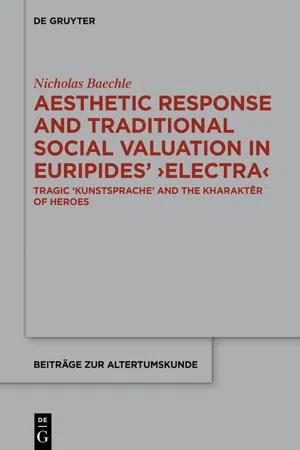
Aesthetic Response and Traditional Social Valuation in Euripides' ›Electra‹
Tragic ›Kunstsprache‹ and the ›kharaktēr‹ of Heroes
- 171 pages
- English
- ePUB (mobile friendly)
- Available on iOS & Android
Aesthetic Response and Traditional Social Valuation in Euripides' ›Electra‹
Tragic ›Kunstsprache‹ and the ›kharaktēr‹ of Heroes
About This Book
Euripides' Electra opened up for its audience an opportunity to become self-aware as to the appeal of tragic Kunstsprache: it both reflected and sustained traditional, aristocratically-inflected assumptions about the continuity of appearance and substance, even in a radical democracy. A complex analogy between social and aesthetic valuation is played out and brought to light. The characterization of Orestes early in the play demonstrates how social appearances made clear the identity of well-born, and how they were still assumed to indicate superior virtue and agency. On the aesthetic side of the analogy, one of the functions of tragic diction, as an essential indication of heroic character and agency, comes into view in a dramatic and thematic sequence that begins with Achilles ode and ends with the planning of the murders. Serious doubts are created as to whether Orestes will realize the assumed potential inherent in his heroic genealogy and, at the same time, as to whether the components of his character as an aesthetic construct are congruent with such qualities and agency. Both sides of this complex analogy are thus problematized, and, at a metapoetic level, its nature and bases are exposed for reflection.
Frequently asked questions
Information
Index of passages discussed
-
- Aristophanes
- Frogs 1058–64
- 1304–28
- Peace 124–39
- Wasps 1157–60
-
- Aristotle
- Rhetoric 1387a8–15
-
- Euripides
- Electra
- 1–53
- 34–9
- 36–42
- 43–9
- 45–53
- 82–111
- 213–28
- 228–89
- 247–62
- 274–82
- 283–7
- 294–6
- 300–38
- 319–31
- 336–8
- 357–63
- 364–7
- 367–90
- 367–72
- 373–9
- 380–5
- 386–90
- 391–400
- 404–7
- 433–51
- 479–81
- 487–502
- 487–92
- 493–500
- 493–4
- 501–2
- 503–12
- 518–46
- 518–26
- 527–31
- 532–7
- 538–44
- 545–6
- 547–57
- 547–9
- 549
- 550–62:
- 550–1
- 558–62
- 563–78
- 577–80
- 581–4
- 599–611
- 618–25
- 640–54
- 655–63
- 664–70
- 685–93
- 1177–232
-
- Plato
-
- Theaetetus 174e5–175b6
Notes
Table of contents
- Title Page
- Copyright
- Contents
- Acknowledgements
- Introduction: The complex analogy between social appearance and stylistic presentation and the provocations to cultural self-awareness played out in Euripides’ Electra
- I The initial presentation of the Old Man: Characterization and stylistic presentation of an oddly mundane, even anti-heroic, tragic character
- II The initial presentation of Orestes: Appearance, eugeneia, and social expectations about character and agency
- III Orestes, eugeneia, and aesthetic expectations about heroic characterization and agency
- IV Achilles and the first stasimon: Stylistic effect and the “appearance” of an heroic character
- V The Old Man again: The Kunstsprache and character construction
- VI The Kunstsprache, defamiliarization, and the metapoetics of character construction
- VII The Old Man and Orestes: The problem of eugeneia in the second episode
- VIII Metapoetics in the abortive first section of the recognition scene
- IX The recognition proper: the kharaktēr of tragic heroes
- X Unquestioned assumptions and the aesthetics of valuation: What can be made of this Orestes?
- Conclusion: Cultural context and tradition: Continuity of substance and appearance and the basis of the complex analogy
- Subject index
- Index of passages discussed